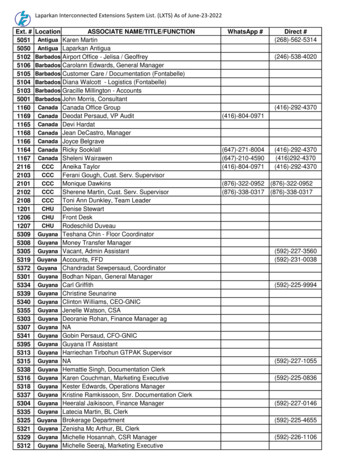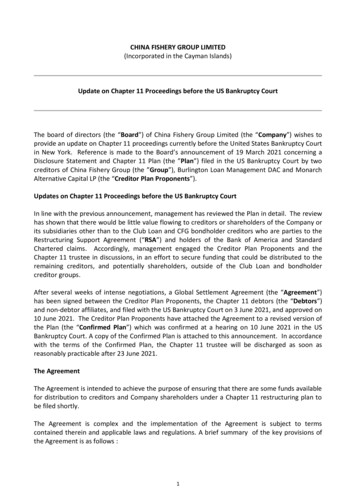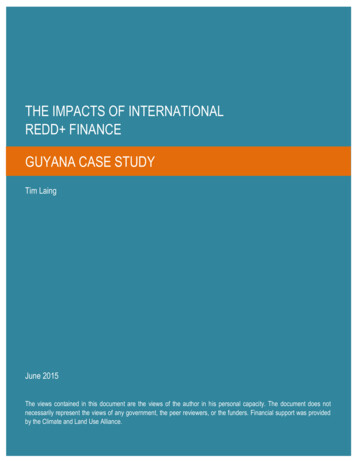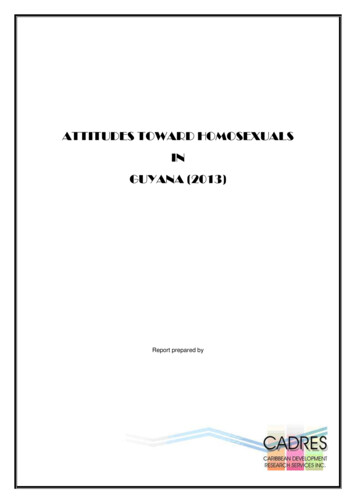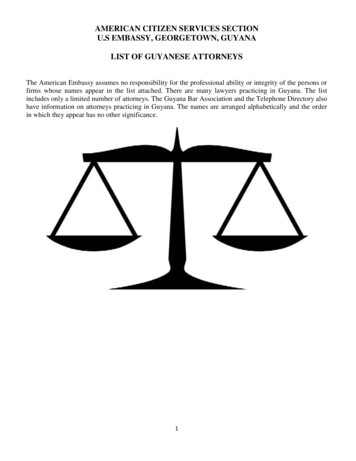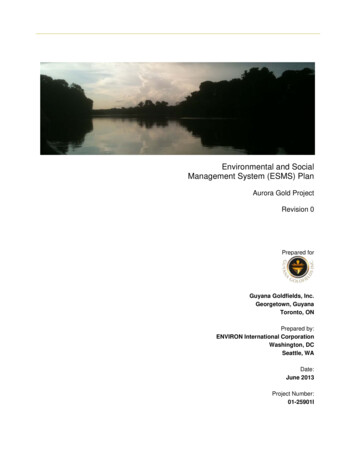
Transcription
AUDITORS’ REPORTTo the Directors of The Bank of Nova Scotia - Guyana BranchWe have audited the accompanying financial statements of The Bank of Nova Scotia - GuyanaBranch; which comprise of the statement of financial position as at October 31, 2013 and thestatements of comprehensive income, changes in equity and cash flows for the year then ended,and a summary of significant accounting policies and other explanatory notes.Management's Responsibility for the Financial StatementsManagement is responsible for the preparation and fair presentation of these financialstatements in accordance with International Financial Reporting Standards. This responsibilityincludes: designing, implementing and maintaining internal control relevant to the preparationand fair presentation of the financial statements that are free from material misstatements,whether due to fraud or error; selecting and applying appropriate accounting policies; andmaking accounting estimates that are reasonable in the circumstances.Auditors' ResponsibilityOur responsibility is to express an opinion on these financial statements based on our audit. Weconducted our audit in accordance with International Standards on Auditing. Those standardsrequire that we comply with ethical requirements and plan and perform the audit to obtainreasonable assurance whether the financial statements are free from material misstatement.An audit involves performing procedures to obtain evidence about the amounts anddisclosures in the financial statement. The procedures selected depend on the auditors'judgement, including the assessment of the risks of material misstatement of the financialstatements, whether due to fraud or error. In making those risk assessments, the auditors considerinternal control relevant to the entity's preparation and fair presentation of the financialstatements in order to design audit procedures that are appropriate in the circumstances, but notfor the purpose of expressing an opinion on the effectiveness of the entity's internal control.An audit also includes evaluating the appropriateness of accounting policies used and thereasonableness of accounting estimate made by management, as well as evaluating the overallpresentation of the financial statements.We believe that the audit evidence we have obtained is sufficient and appropriate to provide abasis for our audit opinion.1
OpinionIn our opinion, the financial statements present fairly, in all material respects, the financialposition of the Bank as at October 31, 2013 and its financial performance and its cash flowsfor the year then ended in accordance with International Financial Reporting Standards.Report on Other Legal and Regulatory RequirementsThe financial statements comply with the requirements of the Financial Institutions Act 1995 andthe Companies Act 1991Chartered AccountsGeorgetown, GuyanaDecember 31,20132
THE BANK OF NOVA SCOTIA – GUYANA BRANCHStatement of Financial PositionOctober 31, 2013( thousands)Notes20132012ASSETSCash on hand and in transitDue from banks and related companiesDeposits with the Central BankInvestment securitiesNet loans to customersAssets classified as held for saleProperty, plant and equipmentDeferred taxOther 545,07962,992,76859,527,0584567891310LIABILITIES, ASSIGNED CAPITAL, RESERVES &HEAD OFFICE ACCOUNTLIABILITIESDepositsDue to banks and related companiesDeferred taxProvision for taxationOther liabilitiesASSIGNED CAPITAL, RESERVES AND HEADOFFICE ACCOUNTAssigned capitalOther capitalStatutory reserve fundGeneral banking risk reserveHead office accountThe accompanying notes form an integral part of these financial statements.The financial statements have been approved for issue by the Country Manager on December 31,2013 and signed accordingly:Amanda V.M.L. St Aubyn3
THE BANK OF NOVA SCOTIA – GUYANA BRANCHStatement of Comprehensive IncomeOctober 31, 2013( thousands)Notes20132012NET INTEREST AND OTHER INCOMETotal interest incomeTotal interest expense1718Net interest incomeOther income19Net interest and other ,838,130NON INTEREST EXPENSESSalaries and benefitsPremises and technologyCommunication and marketingLoan loss expenseOther7.520Total non-interest expenseINCOME BEFORE TAXATIONINCOME TAX EXPENSENET INCOME FOR THE YEAR13APPROPRIATIONSHead officeThe accompanying notes form an integral part of these financial statements.4
THE BANK OF NOVA SCOTIA – GUYANA BRANCHStatement of Changes in EquityOctober 31, 2013( thousands)Assigned OtherCapitalCapitalHeadOfficeAccountStatutory EquityYear ended October 31, 2012Balance as at October 31, 2011251,327801,700251,400- 4,402,5225,706,949---- 1,838,1301,838,130251,327801,700251,400- 6,240,6527,545,079251,327801,700251,400- 6,240,6527,545,079Net income for the year---- 2,117,1502,117,150Withholding tax relating to prioryear deemed profit transfer----(249,990)(249,990)Transfer to general banking 00370,705 7,737,1079,412,239Net Income for the yearBalance as at October 31, 2012Year ended October 31, 2013Balance as at October 31, 2012Balance as at October 31, 2013The accompanying notes form an integral part of these financial statements.5
THE BANK OF NOVA SCOTIA – GUYANA BRANCHStatement of Cash FlowsYear ended October 31, 2013( )CASH AND CASH EQUIVALENTS, BEGINNING OF YEAR8,713,24110,045,495CASH AND CASH EQUIVALENTS, END OF YEAR8,860,4248,713,241CASH FLOWS FROM OPERATING ACTIVITIESIncome before taxationAdjustments to reconcile income before taxation tonet cash from operating activities:Interest incomeInterest expenseDepreciationNet loss on disposal of other assetsNet loss on disposal of property, plant and equipmentChange in deposits with the Central BankChange in due to banks and related companiesChange in loansChange in loan loss provisionChange in depositsChange in other liabilitiesChange in other assetsInterest receivedInterest paidTaxation paidNet cash from operating activitiesCASH FLOWS FROM INVESTING ACTIVITIESChange in investmentsProceeds from disposal of other assetsProceeds from disposal of property, plant and equipmentPurchase of property, plant and equipmentNet cash used in investing activitiesCASH FLOWS FROM FINANCING ACTIVITIESRemittances including withholding taxNet cash used in financing activitiesIncrease / (Decrease) in cash and cash equivalents6
THE BANK OF NOVA SCOTIA – GUYANA BRANCHStatement of Cash Flows (continued)Year ended October 31, 2013( thousands)20132012CASH AND CASH EQUIVALENTSRepresented byCash on hand and in transitDue from banks and related companies862,8047,997,620878,5677,834,674Cash and cash equivalents8,860,4248,713,241The accompanying notes form an integral part of these financial statements.7
THE BANK OF NOVA SCOTIA – GUYANA BRANCHNotes to Financial StatementsOctober 31, 20131. Incorporation and Business ActivitiesThe Bank of Nova Scotia – Guyana Branch (The Bank) was registered on September 23, 1968 asa branch of The Bank of Nova Scotia (Scotiabank), which is incorporated in Canada. During1997, the Bank of Nova Scotia – Guyana Branch obtained a Certificate of Continuance under theCompanies Act of 1991.The Bank offers a complete range of banking and financial services and operates under theprovisions of the Financial Institutions Act 1995.On September 14, 2005 the Bank was designated an approved mortgage finance company inaccordance with Section 15 of the Income Tax Act.2. Significant Accounting PoliciesThe significant accounting policies adopted in the preparation of these financial statements havebeen applied consistently to all periods presented in the financial statements and are set outbelow:2.1 Basis of preparationThe financial statements have been prepared in accordance with International FinancialReporting Standards (IFRS) issued by the International Accounting Standards Board and arepresented in Guyana dollars, which is the functional currency, rounded to the nearestthousand.The financial statements are prepared on the historical cost basis, modified for the inclusionof investments at fair value through profit or loss, available-for-sale investments at fair valueand non-current assets classified as “assets held for sale”The preparation of these financial statements in conformity with IFRS requires managementto make estimates and assumptions that affect the reported amount of assets, liabilities,contingent assets and contingent liabilities at the date of the financial statements and incomeand expenses during the year. Actual results could differ from estimates. The areas involvinga higher degree of judgment or complexity, or areas where assumptions and estimates aresignificant to the financial statements are disclosed in note 3.8
THE BANK OF NOVA SCOTIA – GUYANA BRANCHNotes to Financial StatementsOctober 31, 20132) Significant Accounting Policies (continued)2.2 Revenue recognition2.2.1. Interest incomeInterest income is accounted for on the accrual basis for investments and all loansother than non-accrual loans using the effective interest rate method. When a loan isclassified as non-accrual, accrued but uncollected interest is reversed against incomeof the current period unless the loan, including accrued interest, is fully secured andin the process of collection. Thereafter, interest income is recognised only after theloan reverts to performing status. The Bank of Nova Scotia - Guyana Branch'scalculation of the effective interest rate includes all material fees received,transaction costs, discounts or premiums that are an integral part of the effectiveinterest rate. Transaction costs are incremental costs that are directly attributable tothe acquisition, issue or disposal of a financial asset.2.2.2. Fees and commissionsFees, commissions income and expenses that are material to the effective interest rateon a financial asset or liability are included in the measurement of the effectiveinterest rate. Other fees and commissions are recognised in income when a bindingobligation has been established. Where such obligations are continuing, income isrecognised over the duration of the facility.2.3 Foreign currency translationTransactions in foreign currencies are translated at the rate of exchange ruling at thetransaction date. Foreign currency, monetary assets and liabilities are translated at therate of exchange ruling at the statement of financial position date. Resultingtranslation differences and gains and losses from trading activities are included in thestatement of comprehensive income.9
THE BANK OF NOVA SCOTIA – GUYANA BRANCHNotes to Financial StatementsOctober 31, 20132) Significant Accounting Policies (continued)2.4 Financial assets and liabilitiesFinancial instruments carried on the statement of financial position include cash resources,investment securities, net loans to customers, deposits, other liabilities and amounts due tobanks and related companies. The standard treatment for recognition, derecognition,classification and measurement of The Bank of Nova Scotia - Guyana Branch’s financialinstruments are noted below in notes (i) – (iv).(i) RecognitionThe Bank of Nova Scotia – Guyana Branch initially recognises loans and advances anddeposits on the date that they originated. All other financial assets and liabilities (includingassets and liabilities designated at fair value through profit or loss) are initially recognised onthe trade date at which The Bank of Nova Scotia - Guyana Branch becomes a party to thecontractual provisions of the instrument.(ii) DerecognitionThe Bank of Nova Scotia- Guyana Branch derecognises a financial asset when the contractualrights to the cash flows from the asset expire, or it transfers the rights to receive thecontractual cash flows on the financial asset in a transaction in which substantially all therisks and rewards of ownership of the financial asset are transferred. Any interest intransferred financial assets that is created or retained by The Branch is recognised as aseparate asset or liability.The Bank of Nova Scotia- Guyana Branch derecognises a financial liability when itscontractual obligations are discharged, cancelled or expired.10
THE BANK OF NOVA SCOTIA – GUYANA BRANCHNotes to Financial StatementsOctober 31, 20132) Significant Accounting Policies (continued)2.4 Financial assets and liabilities (continued)(iii) ClassificationThe Bank of Nova Scotia – Guyana Branch classifies its financial assets into the followingcategories: financial assets at fair value through profit or loss; loans and receivables,available-for-sale financial assets and held-to-maturity. Management determines theclassification of its investments at initial recognition.Financial assets at fair value through profit or lossThis category includes financial assets held-for-trading. A financial asset is classified in thiscategory if acquired principally for the purpose of selling in the short term or if so designatedby management.Loans and receivablesLoans and receivables are non-derivative financial assets with fixed or determinablepayments that are not quoted in an active market. They arise when The Bank of Nova Scotia– Guyana Branch provides money or services directly to a debtor with no intention of tradingthe receivable.Available-for-sale financial assetAvailable-for-sale investments are those intended to be held for an indefinite period of time,and may be sold in response to needs for liquidity or changes in interest rates, exchange ratesor equity prices.Held-to-maturityHeld-to-maturity investments are non-derivative financial assets with fixed or determinablepayments and fixed maturities that The Bank of Nova Scotia – Guyana Branch’s managementhas the positive intention and ability to hold to maturity. If the Bank was to sell other than aninsignificant amount of held-to-maturity assets, the entire category would be compromisedand reclassified as available-for-sale.(iv) MeasurementFinancial instruments are measured initially at cost, including transaction costs.Subsequent to initial recognition all financial assets at fair value through profit or loss andavailable-for-sale assets are measured at fair value, based on their quoted market price at thedate of the statement of financial position without any deduction for transaction costs. Wherethe instrument is not actively traded or quoted on recognised exchanges, fair value isdetermined using discounted cash flow analysis.11
THE BANK OF NOVA SCOTIA – GUYANA BRANCHNotes to Financial StatementsOctober 31, 20132) Significant Accounting Policies (continued)2.4 Financial assets and liabilities (continued)(iv)Measurement (continued)Where discounted cash flow techniques are used, estimated future cash flows are based onmanagement’s best estimates and the discount rate is a market related rate at the date of thestatement of financial position for an instrument with similar terms and conditions.Any available-for-sale asset that does not have a quoted market price in an active market andwhere fair value cannot be reliably measured, is stated at cost, including transaction costs,less impairment losses.Gains and losses arising from the change in the fair value of available-for-sale investmentssubsequent to initial recognition are accounted for as changes in the investment revaluationreserve.Gains and losses, both realised and unrealised, arising from the change in the financial assetsat fair value through profit or loss are reported in other income.All non-trading financial liabilities, originated loans and receivables and held-to-maturityassets are measured at amortised costs less impairment losses. Amortised cost is calculatedon the effective interest rate method. Premiums and discounts, including initial transactioncosts, are included in the carrying amount of the related instrument and amortised based onthe effective interest rate of the instrument.2.5 Cash and cash equivalentsCash and cash equivalents consist of cash on hand and in transit, deposits with banks andrelated companies and short-term highly liquid investments with maturities of three monthsor less when purchased. The carrying value approximates the fair value due to its highlyliquid nature and the fact that it is readily converted to known amounts of cash at hand and issubject to insignificant risk of change in value.2.6 Investment securitiesDebt investments that The Bank of Nova Scotia - Guyana Branch has the intent and abilityto hold to maturity are classified as held-to-maturity assets. All other investments areclassified as available-for-sale.On disposal or on maturity of an investment, the difference between the net proceeds and thecarrying amount is included in the statement of comprehensive income. When available-forsale assets are sold, converted or otherwise disposed of, the cumulative gain or lossrecognised in equity is transferred to the statement of comprehensive income.12
THE BANK OF NOVA SCOTIA – GUYANA BRANCHNotes to Financial StatementsOctober 31, 20132) Significant Accounting Policies (continued)2.7 Loans and advancesi)ClassificationLoans and advances to customers comprise of loans and advances originated by the Bank andare classified as financial assets at amortised cost, net of allowances to reflect the estimatedrecoverable amounts.A loan is classified as non-accrual when principal or interest is past due or when, in theopinion of management, there is reasonable doubt as to the ultimate collectibility of principalor interest. Non-accrual loans may revert to performing status when all payments becomefully current or when management has determined there is no reasonable doubt of ultimatecollectibility.ii) Impairment assessmentThe Bank considers a loan to be impaired when there is objective evidence of impairment asa result of one or more loss events that occurred after the date of initial recognition of theloan and the loss event has an impact on the estimated future cash flows of the loan that canbe reliably estimated. Objective evidence is represented by observable data that comes to theattention of the Bank and includes events that indicate: Significant financial difficulty of the borrower; A default or delinquency in interest or principal payments; A high probability of the borrower entering a phase of bankruptcy or a financialreorganization; A measurable decrease in the estimated future cash flows from loan or the underlyingassets that back the loan.The Bank considers evidence of impairment for loans and advances at both an individual andcollective level.Individual impairment allowanceFor all loans that are considered individually significant, the Bank assesses on a case-by-casebasis at each reporting period whether an individual allowance for the loan is required.For those loans where objective evidence of impairment exists and the Bank has determinedthe loan to be impaired, impairment losses are determined based on the Bank’s aggregateexposure to the customer considering the following factors: The customer’s ability to generate sufficient cash flow to service debt obligations; The extent of the other creditors’ commitments ranking ahead of or pari passu with,the Bank and the likelihood of other creditors continuing to support the customer; The complexity of determining the aggregate amount and ranking of all creditor'sclaims and the extent to which legal and insurance uncertainties are evident; and The realizable value of security (or other credit mitigants) and likelihood ofsuccessful repossession.13
THE BANK OF NOVA SCOTIA – GUYANA BRANCHNotes to Financial StatementsOctober 31, 20132) Significant Accounting Policies (continued)2.7ii)Loans and advances, continuedImpairment assessment, continuedCollective impairment allowanceFor loans that have not been individually assessed as being impaired, the Bank pools theminto groups to assess them on a collective basis.Impaired loansRetail loans represented by residential mortgages, credit cards and other personal loans areconsidered by the Bank to be homogenous groups of loans that are not consideredindividually significant. All homogeneous groups of loans are assessed for impairment on acollective basis.A roll rate methodology is used to determine impairment losses on a collective basis for theseloans because individual loan assessment is impracticable. Under this methodology, loanswith similar credit characteristics are grouped into ranges according to the number of dayspast due and statistical analysis is used to estimate the likelihood that loans in each range willprogress through the various stages of delinquency and ultimately prove irrecoverable. Thismethodology employs statistical analysis of historical data and experience of delinquency anddefault to estimate the amount of loans that will eventually be written off as a result of theevents not identifiable on an individual loan basis. When the portfolio size is small or wheninformation is insufficient or not reliable enough to adopt a roll rate methodology, the Bankadopts a basic formulaic approach based on historical loss rate experience.The provision for the year, less recoveries of amounts previously written off and the reversalof provision no longer required, is disclosed in the statement of comprehensive income as aprovision for loan losses net of recoveries.Loans are written off after all the necessary legal procedures have been completed and theamount of the loss is finally determined.iii)General banking risk reserveThe Bank also carries out a detailed review of its loan portfolio twice yearly in accordancewith the requirements of the Financial Institutions Act (FIA) 1995. The General BankingRisk Reserve is created as an appropriation of retained earnings for the difference betweenthe specific provision and the carrying amount of non-performing advances.2.8 Assets held for resaleA non-current asset is classified as held for sale when: its carrying amount will be recoveredprincipally through a sale transaction; the asset is available for immediate sale in its presentcondition and its sale is highly probable. Assets classified as held for sale are not depreciatedor amortised and are carried at the lower of carrying amount and fair value less cost to sell.14
THE BANK OF NOVA SCOTIA – GUYANA BRANCHNotes to Financial StatementsOctober 31, 20132) Significant Accounting Policies (continued)2.9 Property, plant and equipmenti)Recognition and measurementPremises and equipment are carried at cost less accumulated depreciation andimpairment losses.Cost includes expenditure that are directly attributable to the acquisition of the asset.The cost of self-constructed assets includes the cost of materials and direct labour andany other cost directly attributable to bringing the asset to a working condition for itsintended use. Purchased software that is integral to the functionality of the relatedequipment is capitalised as part of that equipment. The Bank of Nova Scotia – GuyanaBranch has not incurred any significant expenditure on software that is not an integralpart of related hardware as classified under property, plant and equipment.ii) Subsequent costThe cost of replacing part of an item of property, plant and equipment is recognised inthe carrying amount of the item if it is probable that the future economic benefitsembodied within the part will flow to the Bank and its cost can be measured reliably.The cost of the day-to-day servicing of property, plant and equipment are recognised inthe statement of comprehensive income as incurred.15
THE BANK OF NOVA SCOTIA – GUYANA BRANCHNotes to Financial StatementsOctober 31, 20132) Significant Accounting Policies (continued)2.9Property, plant and equipment (continued)iii) DepreciationDepreciation of property, plant and equipment excluding land, is provided for, over theestimated useful lives of the respective assets using the straight-line method.The following annual depreciation rates are applicable for the respective assetcategories: BuildingLeasehold improvementsEquipment, furniture andfixtures and computer equipmentMotor vehiclesWork in progress2%33 1/3%5% - 33 1/3%25%Nil2.10 TaxationIncome tax expense comprises current tax and the change in deferred tax. Current tax comprisestax payable calculated on the basis of the expected taxable income for the year, using the tax rateenacted at the reporting date and any adjustment of tax payable for previous years.Deferred tax is provided using the balance sheet method on all temporary differences betweenthe carrying amounts for financial reporting purposes and the amounts used for taxationpurposes, except differences relating to the initial recognition of assets or liabilities whichaffect neither accounting nor taxable income (loss). Net deferred tax assets are reduced to theextent that it is no longer probable that the related tax benefit will be realised.Deferred tax is calculated on the basis of the tax rate that is expected to apply to the periodwhen the asset is realised or the liability is settled. The effect on deferred tax of any changesin the tax rate is charged to the statement of comprehensive income, except to the extent thatit relates to items previously charged or credited directly to equity.16
THE BANK OF NOVA SCOTIA – GUYANA BRANCHNotes to Financial StatementsOctober 31, 20132) Significant Accounting Policies (continued)2.11 Employee benefitsEmployee benefits are all forms of consideration given by The Bank of Nova Scotia –Guyana Branch in exchange for service rendered by employees. These include current orshort-term benefits such as salaries, bonuses, NIS contributions, annual leave, and nonmonetary benefits such as medical care and loans; post-employment benefits such as pensionsand other long-term employee benefits such as termination benefits.Employee benefits that are earned as a result of past or current service are recognised in thefollowing manner: short-term employee benefits are recognised as a liability, net of paymentsmade, and charged as an expense.All regular full-time employees become members of the Scotiabank pension plan after twentyfour (24) months of continuous service with the Bank. The plan is being administered byHead Office. Normal retirement age is sixty five (65) years and membership of the plan isnon-contributory.The Bank is not exposed to any obligation, since such obligation will be met by its HeadOffice.2.12LeasesLease arrangements in which a significant portion of the risks and rewards of ownership areretained by the lessor, are classified as operating leases. Payments made under operatingleases are charged to The Statement of Comprehensive Income on a straight line basis overthe period of the lease. All leasing arrangements to which the Bank is a party are consideredas an operating lease.2.13Segment reportingAn operating segment is a distinguishable component of the Bank that is engaged in businessactivities from which it may earn revenues and incur expenses, including revenues andexpenses that relate to transactions with any of the Bank’s other components, whose resultsare reviewed regularly by management to make decisions about resource allocation to eachsegment and assesses its performance, and for which discrete financial information isavailable.2.14Acceptances, guarantees and letters of creditThe Bank of Nova Scotia – Guyana Branch’s commitments under acceptances, guaranteesand letters of credit have been excluded from these financial statements because they do notmeet the criteria for recognition. These commitments as at October 31, 2013 total 815million (2012 - 956 million). In the event of a call on these commitments, the Bank hasequal and offsetting claims against its customers.17
THE BANK OF NOVA SCOTIA – GUYANA BRANCHNotes to Financial StatementsOctober 31, 20132) Significant Accounting Policies (continued)2.15 Deposit liabilitiesThe estimated fair values of deposit liabilities are assumed to be equal to their carryingvalues, since the rates are not materially different from current market rates and discountingthe contractual cash flows would approximate the carrying values.2.16ImpairmentThe carrying amounts of The Bank of Nova Scotia – Guyana Branch’s assets are reviewed ateach statement of financial position date to determine whether there is any indication ofimpairment. If any such indication exists, the asset’s recoverable amount is estimated.An impairment loss is recognised whenever the carrying amount of an asset or its cashgenerating unit exceeds its recoverable amount. Impairment losses are recognised in thestatement of comprehensive income.The recoverable amount of other assets is the greater of their net selling price and value inuse. In assessing value in use, the estimated future cash flows are discounted to their presentvalue using a pre-tax discount rate that reflects current market assessments of the time valueof money and the risks specific to the asset. For an asset that does not generate largelyindependen
Companies Act of 1991. The Bank offers a complete range of banking and financial services and operates under the provisions of the Financial Institutions Act 1995. On September 14, 2005 the Bank was designated an approved mortgage finance company in accordance with Section 15 of the Income Tax Act. 2. Significant Accounting Policies
